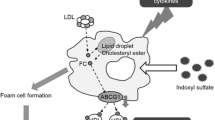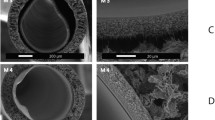Abstract
Chitosan resins, which clinically served as adsorbents in hemo perfusion therapy, were prepared with reversed-phase suspension methodology using three differently structured crosslinking agents, methanal, glyoxal and glutaraldehyde. And the glyoxal and glutaraldehyde crosslinked chitosan resins were reduced with NaBH4 afterwards. By analyzing the results from FTIR and SEM, it was found that the reduction treatment to the adsorbents efficiently improved the chemical stability of these chitosan resins, and the shifts in crosslinking agents exerted influences over the morphologies of the adsorbents obviously. After being put to use in the adsorption tests upon some model uremic middle molecular toxins and BSA in vitro, all three adsorbents demonstrated a fairly realistic adsorption capability to the model toxins but little to BSA. And the adsorption process reached the equilibrium in a clinically qualified short time. But the adsorption capacities of these adsorbents to the model toxins were quite different. It had been found that with the growing of fatty chain length of crosslinking agent, these adsorbents showed a gradually increased adsorption capacity to the model toxins, and the glutaraldehyde crosslinked chitosan resin behaved best.
Similar content being viewed by others
References
Yu, Z. Y., Blood Purification, 2nd ed., Beijing: Modern Publishing House, 1994, 273.
Babb, A., Popovich, R., Christopher, T. et al., The genesis of the square meter-hour hypothesis, Trans. Am. Soc. Artif Intern. Organs., 1971, 17: 81.
Babb, A., Farrell, R., Uvelli, D. et al., Hemodialyzer evaluation by examination of solute molecular spectra, Trans. Am. Soc. Artif. Intern. Organs., 1972, 18: 98.
Babb, A., Strand, H., Uvelli, D. et al., Quantitative description of dialysis treatment: A dialysis index, Kidney Int., 1975, 5: 23.
Scribner, G. E., The search for the uremic toxin(s), Kidney Int., 1975, 7: 270–274.
Giovanetti, S., Barsotti G, Uremic intoxication, Nephron., 1975, 14: 123.
Zimmerman, L., Jörnvall, H., Bergström, J. et al., Characterization of middle molecule compounds, Int. J. Artif. Organs (Suppl.), 1980, 4:33.
Yuan, Z., Zhang, J., Zhao, F. Z. et al., Isolation and preliminary characterization of properties of middle molecules from sera of uremic patients, Chemical Journal of Chinese Universities (in Chinese), 1989, 10: 401.
Yuan, Z., He, B. L., The proposal and advances of middle molecule hypothesis, Ion Exchange and Adsorption (in Chinese), 1997, 13(1): 98.
Chu, J. G, Yuan, Z., Teng, X. L. et al., Separation and analysis of middle molecular substances from both of uremic and normal sera, Science in China, Series B (in Chinese), 2000, 30(3): 250.
Fürst, P., Bergström, J., Gordon, A. et al., Separation of peptides of “middle molecular” weight from biological fluids of patients with uremia, Kidney Int., 1975, 7: 272.
Zimmerman, L., Baldesten, A., Bergström, J. et al., Isotachophoretic separation of middle molecule peptides in uremic body fluids, Clin. Nephrol., 1980, 13: 183.
Mabuchi, H., Nakahashi, H., Medium-sized peptides in the blood of patients with uremia, Nephrol., 1983, 33: 232.
Mabuchi, H., Nakahashi, H., Profiling of urinary medium sized peptides in normal and uremic urine by high-performance liquid chromatography, J. Chromatogr, 1982, 233: 107.
Mabuchi, H., Nakahashi, H., Analysis of middle molecular peptides in normal and uremic body fluids by high-performance gel chromatography, J. Chromatogr., 1981, 224: 322.
Flanagan, R. W. J., Murphy, R. F., Buchanan, K. D., Circulating forms of glucagon and related peptides in normal subjects and uraemic patients, Biochem. Soc. Transt., 1980, 8: 426.
Matthaei, D., Ludwig-Köln, H., Kramer, P. et al., Changes of plasma hormone levels in hemofiltration, Int. J. Artif. Organs, 1983, 6:21.
Ehrlich, R. W., Holland, F., Turnham, T. et al., Osmotic concentration of polypeptides from hemofiltrate of uremic patients, Clin. Nephrol., 1980, 14: 31.
Menyhart, J., Grof, J., Many hitherto unknown peptides are principal constituents of uremic “middle molecules”, Clin. Chem., 1981, 27: 1712.
Wang, S. X., Wu, J. P., Nephrology, Beijing: People’s Health Publishing House, 1987, 740.
Chu, J. G, Investigations on the separation, characterization and toxicity of middle molecular substances, Doctoral Dissertation, Nankai University, 2000, 108.
Author information
Authors and Affiliations
Rights and permissions
About this article
Cite this article
Wang, H., Yuan, Z., Liu, X. et al. Investigations on the adsorbents for uremic middle molecular toxins (II). Sc. China Ser. B-Chem. 44, 457–464 (2001). https://doi.org/10.1007/BF02880674
Received:
Issue Date:
DOI: https://doi.org/10.1007/BF02880674




